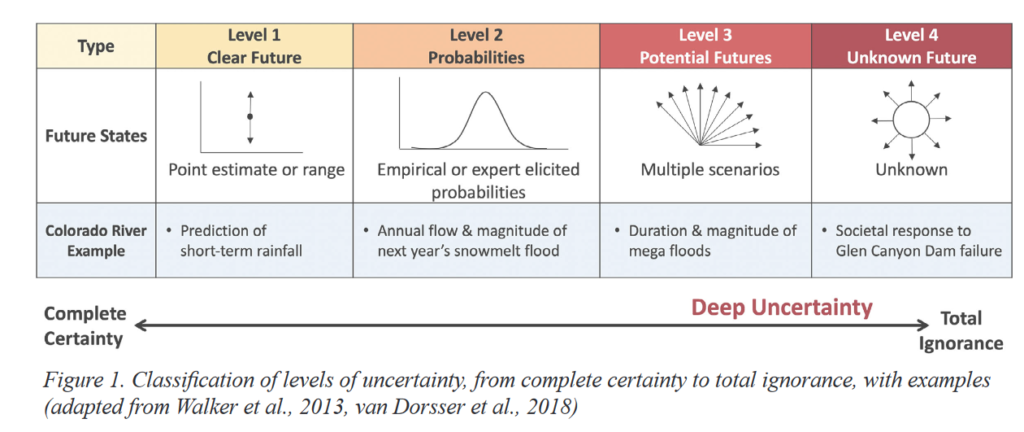One of the great lessons of the last two decades on the Colorado River is the futility of the “search for certainty”. No one number for “the flow of the Colorado River” can allow us to plan for the future. We face the formidable task of building a river new management framework that is robust to the challenges of deep uncertainty.
Jian Wang, David Rosenberg, and colleagues at Utah State’s Center for Colorado River Studies have a valuable new paper that provides a helpful framework for the task.

Deep uncertainty on the Colorado River
I’ve been involved a bit in the discussions as Wang, Rosenberg, and colleagues were developing the paper (I’m on the advisory panel for their Future of the Colorado River Project) and I’ve found their framework super helpful in thinking about the issues Eric Kuhn and I wrote about in our new book, both in terms of what happened in the past and in planning next steps.
The problems Eric and I describe in the development of the river over the first half of the twentieth century look an awful lot like a failure to squeeze the Colorado’s messiness into a “Level 1” certainty box. The river’s developers tried to estimate a single number for “the flow of the river”, and did so badly. It’s easy to see the mess created when they got the number wrong – trying to squeeze 17.5 million acre feet of allocation into a 13 million acre foot river. But the deeper problem was in thinking there was a single number at all.
By the 1960s, we began to see a more probabilistic approach, implicitly recognizing “Level 2” uncertainty. Folks had realized they didn’t have 17.5maf to work with, and further that the river’s ups and downs meant planning for a range rather than a single number.
River management does a far better job today of Level 2 thinking, with serious probability modeling that includes paleoclimate stuff (using tree rings) and climate change modeling of the future.
What we’ve not done is find our way to methods for Level 3 thinking – far more variable phenomena for which we don’t have the modeling tools to even build a meaningful probability curve. How do you develop management tools for that?
The new Wang et al. paper takes a helpful stab at framing that thinking.

I glanced through this analysis. The two dams produce an enormous amount of renewable electricity. I strikes me that any analysis ought to consider the reduction in fossil fuel produced power. There is at least one strategy that could continue power production at Powell even though regular levels decline.
There seems to be a possible set of choices on the decision tree that would choose power production and GHG reduction over water diversion and supply. Users should make do with less water. Users can be more efficient and can eliminate some of their uses. Not water golf courses, for example. Close car washes. no water for lawns. Increase rates above certain demand levels, as with electricity. Limit trans-mountain diversions to the Colorado eastern slope.